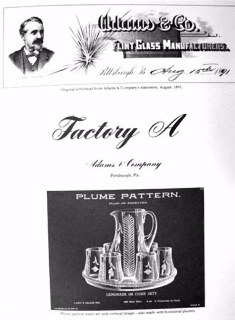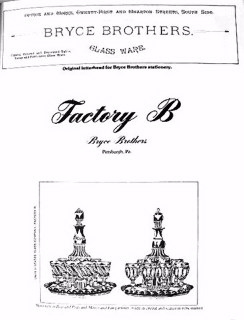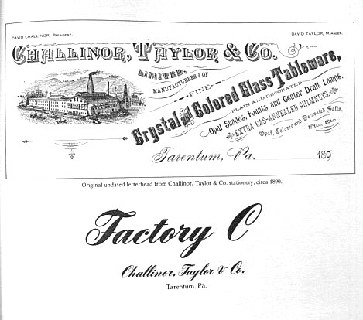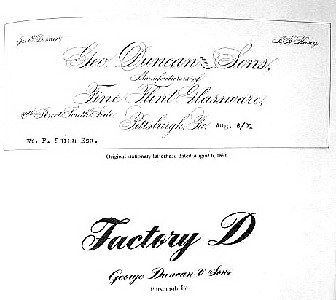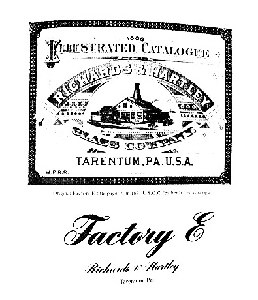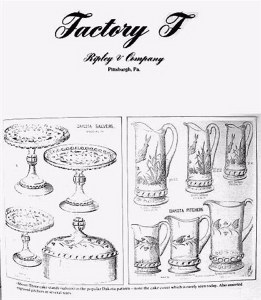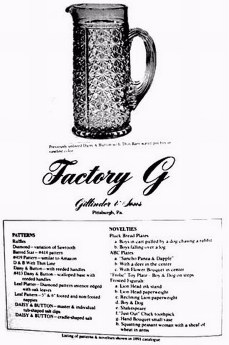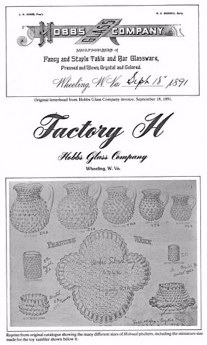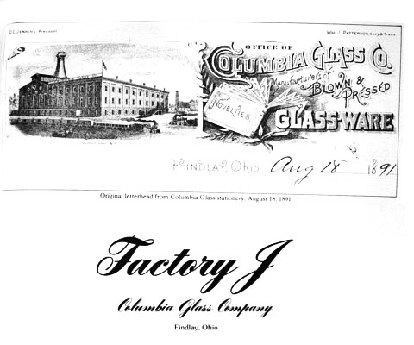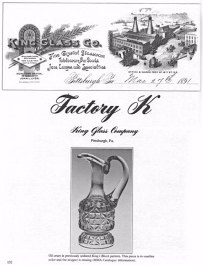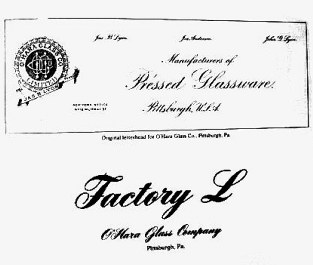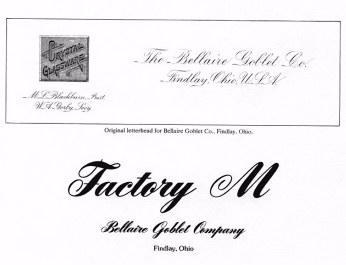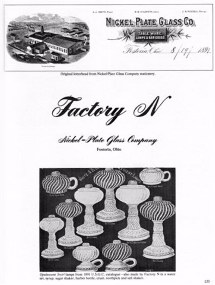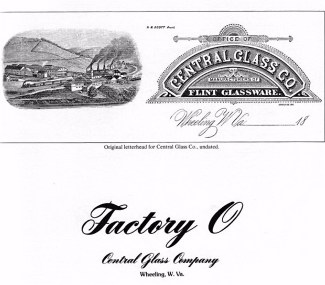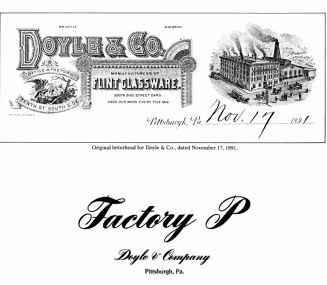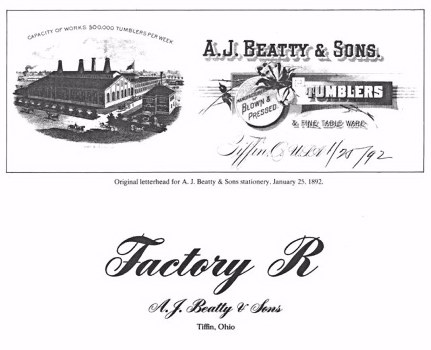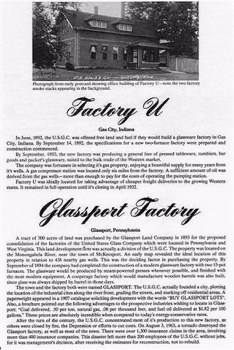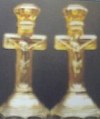Carnival Glass 101 | home Quick Reference to Carnival Glass Patterns on This Site
US Glass Review
U.S. GLASS COMPANY Conglomerates
In February 1890, the New York Sun reported that window glass manufacturers were forming a stock company. The name chosen was the American Window Glass Company, central office in Chicago, about sixty concerns participating. Expected capital had been $600,000, but it fell short by a third, Pittsburgh companies subscribing more than $200,000. A committee of five from the central agency allocated stock in the company in amounts relative to the glass sold.
Uniting the major tableware factories presented more intricate problems, and developments proceeded more slowly. These manufacturers, jealous of individual rights and power had long copied, adopted, even pirated competitors’ designs. The O’Hara Company, for example, at one time had as many as 400 molds in storage representing many patterns. When production was reduced under consolidation, each member could be forced to relinquish a favorite pattern to the controlling company.
There had been a few temporary associations before this in the glass trade, mainly to present a unified front against labor, to regulate prices and production, and to seek governmental favors. Partnerships were constantly changing and many companies, because of hard times, failed or reorganized. The background for a pool, therefore, was somewhat weak.
Tableware men of Pittsburgh and the Upper Ohio Valley met twice in October 1889, ostensibly to discuss the scale of wages. By the following July they were talking openly of regulating production, of maintaining prices, of widening the field of operations. They reached a tacit understanding that in the event of a consolidation, output would not be restricted beyond the needs of the trade; there would be no wholesale dismissal of executives; the number of shops (working teams) would be decreased but no factories would be closed; and prices of wares would be maintained at a level that would permit a favorable balance.
The cartel was completed and took effect on July 1, 1891, as the United Sates Glass Company, with Daniel C. Ripley, Jr., as first president. The cover of the new company’s catalogue gave the list of member companies, each carrying an identifying letter by which it was to be known.
They were:
Click on small pictures or the links below the pictures for a larger view.
Factory catalogues were absorbed and incorporated, often in toto, into the cartel catalogue, though the United States Glass Company undoubtedly did not produce many of the single items and patterns it showed. It soon became apparent that the agreement to keep officers and executives at their posts made for an unwieldy organization; two years after the consolidation there was a purge of vice presidents.
If the cartel was organized in the belief that it could settle the companies’ labor troubles, it was wrong. One of the Company’s first demands was that the American Flint Glass Workers agree to lift all restrictions on output of their member - workmen. The union, of course, refused to give up a traditional right in the industry, and a three-year strike (1893 -1896) followed. Both sides lost. The union gave in on the issues of restrictions on productivity and introduction of new labor-saving machinery and so lost much of its power. A number of companies closed by the strike never reopened, and the United States Glass Company itself never fully recovered from the losses it suffered in the strike.
In November 1899, nineteen companies merged to create the National Glass Company, under the presidency of Rochester’s Henry C. Fry. They were manufacturers of tableware products of lesser variety and excellence; they were strongest in production of tumblers, goblets, and novelties; only one of the nineteen (McKee and Brothers) was located in Pittsburgh.
The failure and dissolution of the combine by 1903 indicated the looseness of its organizational ties.
The cartels mark the end of an era in American glass. Open competition among many small rivals, with all its problems of economy and production, has passed; twentieth-century efficiency and assembly line mass production were being born. Factories lost their identity and managers their freedom to act.
In 1910, the U.S.G.C. brought out many new patterns which they arranged into assortments. These were known as “Glorious”, “Four Beauties”, “Four Charmers”, and “Big Success”, the latter consisting of plain ware. There were also three new etched patterns, known as the “Baroness”, “Duchess”, and “Empress”, each comprised of a long line of stemware and tumblers.
In this year, the U.S.G.C. was operating the following factories:
During 1910 a brand new factory was being built at the Glassport complex which was known as Factory “O” and a decorating shop which was known as factory “N”. So as not to confuse our readers, these are not the same factories originated in 1891. The U.S.G. C. continued to be in business for another 63 years, producing many of the collectable glassware patterns of today. Marble glass, iridescent carnival, and stretch glass were all produced in later years, and the company would experiment with glass equaling that of Tiffany. The cut and etched glass of the Tiffin factory and the hand-painted lamps with the reverse paintings on the shades are all sought by collectors today.
Dean & Diane Fry - 8-10
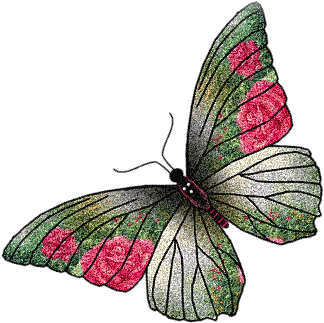





This know also, that in the last days perilous times shall come.
For men shall be lovers of themselves, covetous, boasters,
proud, blasphemers, disobedient to parents,
Unthankful, unholy, without natural affection, trucebreakers, false accusers,
Incontinent, fierce, despisers of those that are good. Traitors heady, high-minded,
Lovers of pleasures more than lovers of God;
Having a form of godliness, but denying the power thereof;
From such turn away. ~~~~ (2 Timothy 3:1-5-King James Bible)







Should you care to contact the Frys, their email address is:
Search Carnival Glass 101
back to Carnival Glass 101
Our other sites you may enjoy:
Everything you EVER wanted to know about Indiana Glass
Great Reference for Newer Carnival Glass.
Complete Glassware Catalogs Available to Download
Questions? Comments? Suggestions? Broken Links? Corrections?
Your Friendly Webmaster is here to help!
